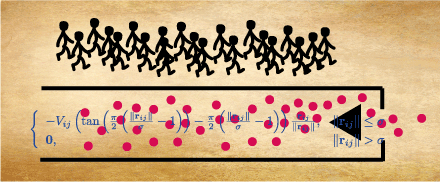|
Industrial Mathematics
Connecting research mathematics with industrial problem solving is one of the
most exciting and rewarding activities I have taken part in. Discovering the
surprisingly complex and often difficult mathematical issues at play in very down-to-earth
settings is a source of wonder, inspiration and hard work. Many different fields
of mathematics may come into play.
Working with others is
highly recommended.

Crowd Dynamics
The study of crowd motions is important because
increasing populations concentrations in the built environment
require an understanding of the complex dynamics of many agents moving
and simultaneously interacting with each other and with physical boundaries,
walls, and obstacles. A mix of dynamical systems theory, experiments
and data analysis from simulations is able to make progress in this area
where lack of first-principles presents a special challenge.

Dynamical Systems, Classical Mechanics.
The science of Dynamical Systems is the study of systems that evolve
according to some underlying principle. A large number of mathematical
techniques are involved; often ordinary or partial differential equations (when
the system changes smoothly). Classical Mechanics is the study of
mechanical systems that are governed by Newton's, Lagrange's, Hamilton's,
or Einstein's equations of motion (as opposed to, e.g., quantum mechanical
equations of motion).

Finite Metric Spaces,
Global Analysis, Differential Geometry.
Among the mathematical tools used in the study of dynamical systems
are the subjects of Differential Geometry, and, more generally,
Global Analysis. They are also beautiful and profound mathematical
disciplines in their own right. Recently I have explored, with S.
Markvorsen and others, the connecetions between the linear algebra
of metric matrices (the metric information in a finite metric space) and
the geometry of the (potentially) imbedding space. Which geometric
properties of the space reveal themselves as matrix properties of
generic metric matrices? Only one thing is clear: the final word. has
not yet been spoken.
|

